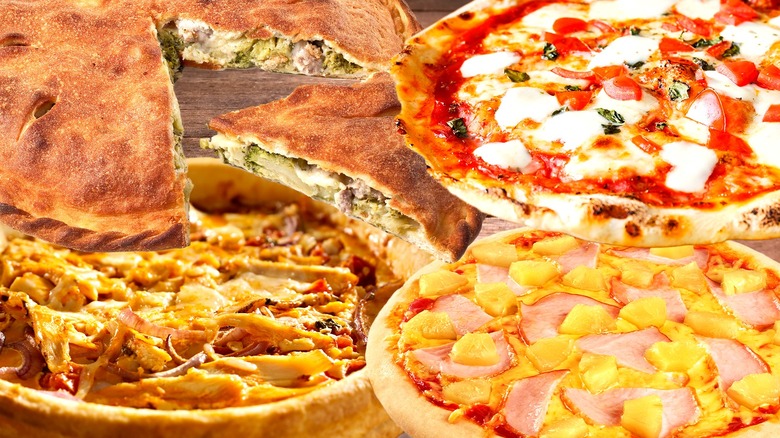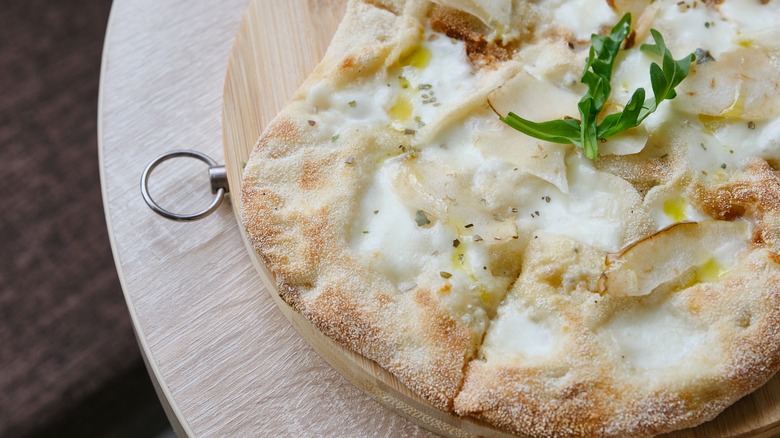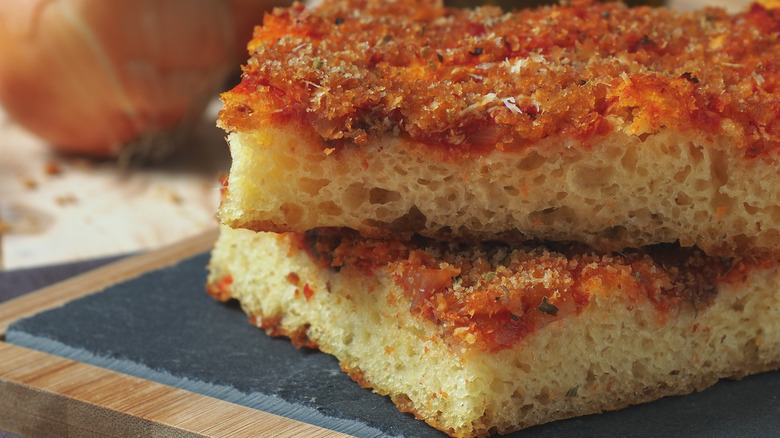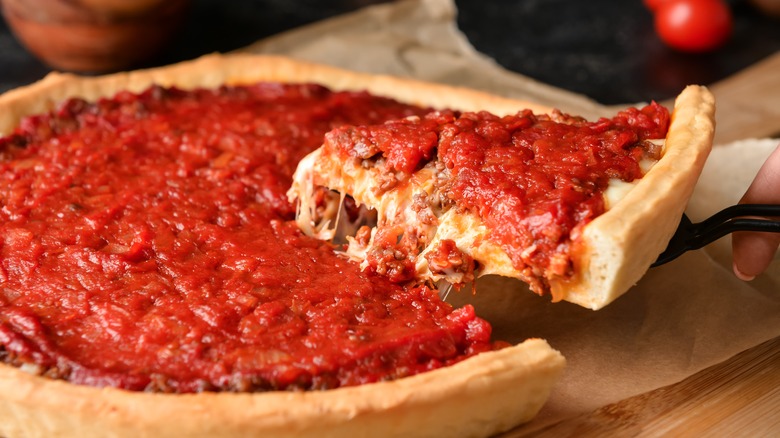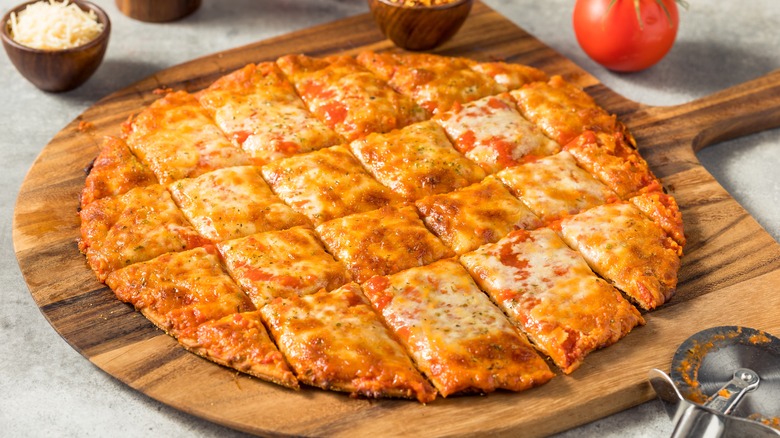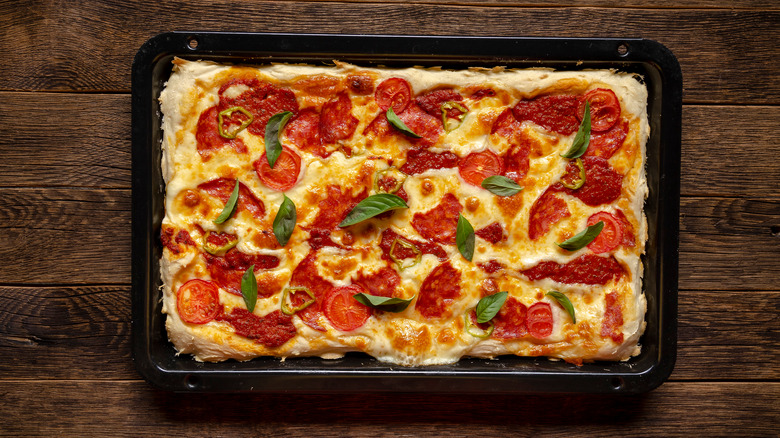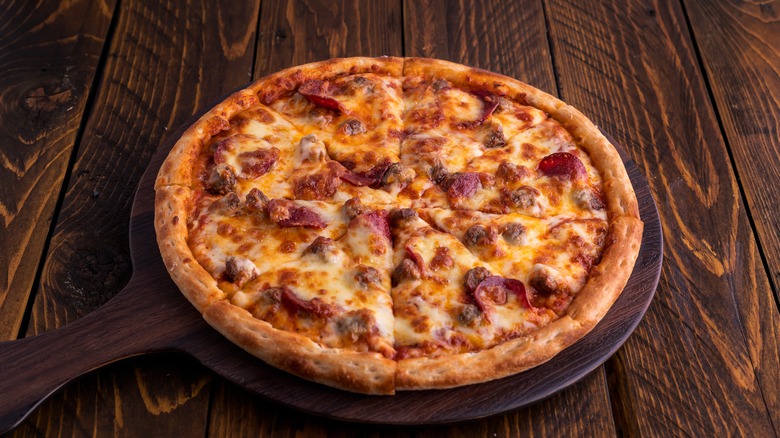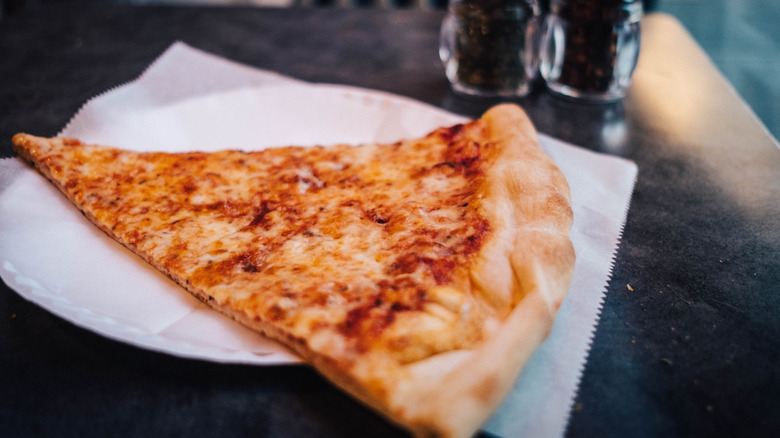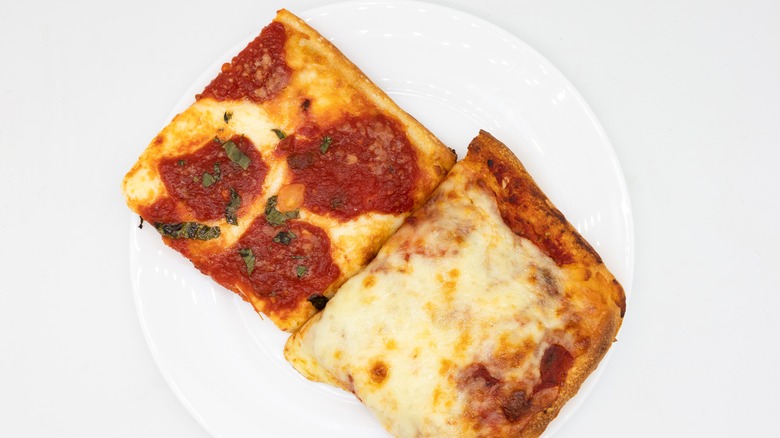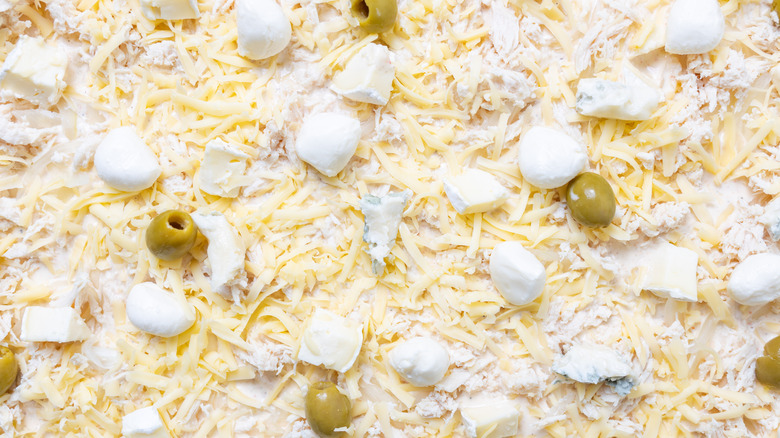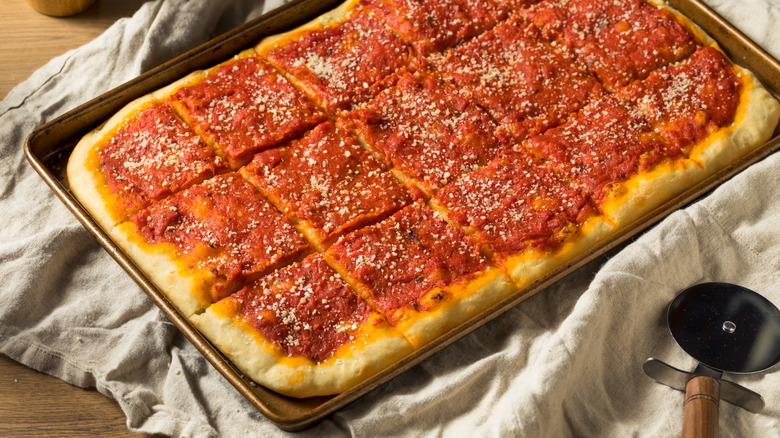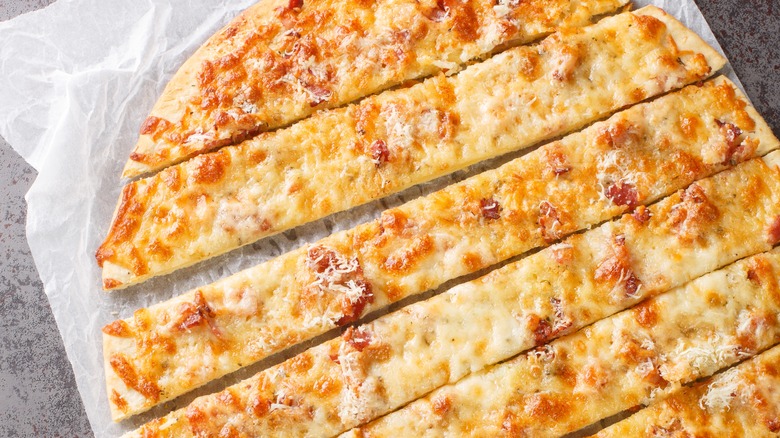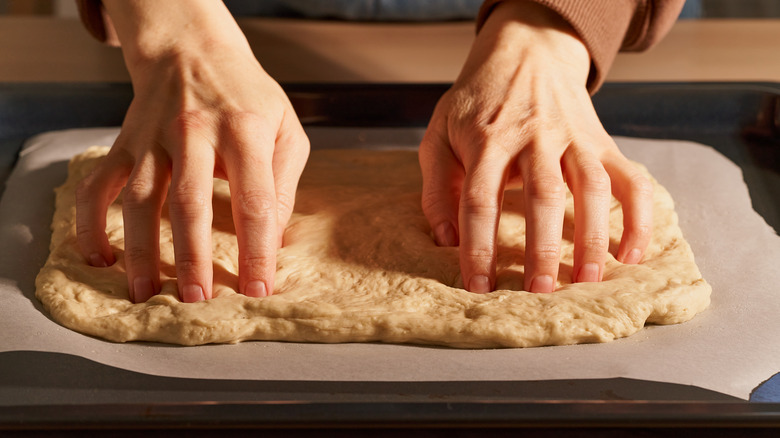The Ultimate Guide To Regional Pizza Styles
Pizza might seem like an easy food to agree on. It's made from a dough base that is topped with zesty tomato sauce, melted cheese, and perhaps some pepperoni or sausage. But the reality is that "pizza" is less a food than it is a category. For a New Yorker, pizza is a thin, folded slice meant to be enjoyed on the go. For a Rhode Islander, pizza takes the form of a strip and cheese is minimal if it's present at all. In New Haven, pizza may come bedecked with clams. In the Quad Cities, it's a vehicle for fennel-laced sausage. And that's just the beginning.
What follows is a deep dive into regional variation — and, for the strong of stomach, a to-do list of gargantuan proportions. Indeed, it may well be the most exhaustive list of regional pizza types ever. Whether your tastes run thin-crust or thick, cheesy or cheese-less, if you like pizza, you're sure to find something to fall for.
Neapolitan pizza
Widely perceived as the home of pizza, Naples lore claims that the original pizza was invented by Neapolitan pizzaiolo Raffaele Esposito in 1889 to honor Queen Margherita of Savoy. Dubbed the pizza margherita, its toppings called to mind the flag of the newly-unified Italy: red tomatoes, white mozzarella, and green basil.
These days, the Associazione Verace Pizza Napoletana (AVPN) requires any pizza bearing the Neapolitan name to begin with hand-worked dough made with soft-grain flour, fresh yeast, sea salt, and water. The pizza must be topped with Italian plum tomatoes and buffalo milk mozzarella, and it must be cooked on the floor of a traditional domed pizza oven. Resulting pizzas, according to Gennaro Esposito, owner and chef of the AVPN-certified A Casa Mia, should be "soft and pliable, not soggy."
American pizza lovers may be surprised to learn that Neapolitan pizza is sold as whole pies to be consumed with a fork and knife. Neapolitan street pizza is meant to be enjoyed "a portofoglio" (wallet-style), folded in quarters.
Roman al taglio pizza
In Rome, two different regional pizza styles compete for local affection. First, there's pizza al taglio which is sold "by cut." Boasting a thin, airy crust, this style is usually baked in an electric oven and may feature one of a wide variety of toppings that are often driven by the seasons. Prospective diners approach the counter and inspect the offerings, indicating which of the crispy, thin-crust pies they'd like to sample and the amount they'd like, either by showing the person behind the counter or simply by asking for the right amount by weight. Prices are typically either listed by the kilogram or a 100-gram portion, which is equivalent to about 3.5 ounces.
Since most al taglio spots don't offer seating, this style of pizza is widely perceived as street food. What's more, many of these spots are open until the wee hours, making al taglio pizza just as welcome for lunch, dinner, snack, or a late-night nibble.
Roman tonda pizza
In addition to the street food favorite of pizza al taglio, Rome is also home to a second regional style that, at first glance, couldn't be more different. Where al taglio is rectangular, tonda is round; where al taglio is sold as street food, tonda is meant to be enjoyed while seated at a restaurant, and with a fork and knife. That said, despite some perceived similarities to its neighbor to the south, there are significant differences. Unlike Neapolitan pizza, Roman tonda pizza boasts the same crispy, thin crust as Roman al taglio, helping to make it wholly distinct from both.
The best pizza tonda will boast a crust that's charred and subtly smoky, with a pleasant crunch or crackle when you dig in. Much like Rome's other pizza style, tonda pizza can come bedecked with a host of different toppings, from classic margherita to pancetta and caciocavallo cheese. You might also go for that oh-so-Roman staple, the humble but delicious artichoke.
Sicilian pizza
South of the boot, the island of Sicily boasts its own pizza style with a "more-is-more" mentality. It begins with a thick, focaccia-like crust, which lends this style its local name of sfincione (large sponge). Atop this thick, square base, Sicilian pizza typically features a rich, garlic-infused sauce and more assertive pecorino in place of gooey mozzarella. The strong flavors don't stop there. Local toppings may include onions, herbs, olives, or anchovies for pizza with pronounced and delicious flavor.
The toppings aren't the only thing that makes this style, which originated in Palermo, stand out. Pizzaiolos who specialize in sfincione will often invert the typical order of the toppings, adding sauce at the end to protect the cheese from burning and to keep the dough from becoming soggy. While this might seem a bit odd, it's shared by yet another regional style, albeit one on the other side of the Atlantic.
Chicago deep dish pizza
The regional pizza style Jon Stewart famously denigrated as a casserole is yet another one that inverts the typical order of pizza toppings — and that's not the only way it stands out. Chicago deep-dish pizza begins not with the thin pizza dough beloved by most other regions, but with a buttery, flaky base that may be made with cornmeal in addition to wheat flour. The resulting crust is quite rich compared to other styles of pizza.
This dough lines the deep dish that gives the pizza its name, at which point it is layered with cheese, then toppings, and finally tomato sauce. Given the longer bake time such a consequential pizza needs, this thick coating of sauce helps to protect the cheese and toppings from burning. The resulting pizza may not be a casserole, but it's far more deserving of the "pie" moniker common to this culinary category.
Chicago tavern-style pizza
Deep dish may be Chicago's best-known pizza style, but it's not the only one — nor, for that matter, is it the one most Chicagoans hold near and dear. That honor falls to tavern-style pizza. Despite their shared homeland, the two pizza styles are worlds apart.
Where deep dish is thick and brimming with fillings, tavern-style is known for its cracker-thin crust. Where deep-dish is served in triangle-shaped wedges evoking a savory pie, round tavern-style pizzas are typically cut into small squares perfect for sharing. Where deep-dish is known for having a buttery crust all around the pizza, tavern-style toppings typically cover the pizza more completely to ensure that edge pieces aren't devoid of cheese or sauce. Unlike many other regional styles of thin-crust pizza, tavern-style pies are baked, not in a wood-fired oven, but in an electric or gas-powered one, meaning their crisp crust is rarely charred or blistered.
Colorado-style pizza
Colorado-style pizza is yet another hearty pizza style, this time invented by Beau Jo's Pizza in the mountain town of Idaho Springs. It starts with a unique dough that's been spiked with sweet honey, forming a hearty base boasting a high, braided crust that resembles the Colorado mountains. This base isn't just designed for aesthetic appeal. Instead, it's essential to support the sheer quantity of toppings diners can add to their pizza. These can include a variety of meats like pepperoni or andouille sausage, veggies like mushrooms or roasted red peppers, and a mix of up to four cheeses including mozzarella, cream cheese, provolone, cheddar, ricotta, and feta.
With so many toppings, it's hardly surprising that this pizza style, much like Roman al taglio, is sold not by the slice but by weight. The restaurant recommends about "a pound per hungry person." To gild the lily, diners can also opt for even more honey to top their crusts, turning what remains of that mountainous, monumental pizza into a built-in dessert.
Detroit-style pizza
Much like Sicilian-style pizza, Detroit-style pizza begins with a focaccia-syle dough seasoned with olive oil. Baked in a rectangular tray, pizzas emerge from the oven with a crisp base topped with a gooey layer of cheese that, similar to Chicago tavern-style, stretches from edge to edge. In keeping with the cheese-first style of Chicago deep-dish, the buttery Wisconsin brick cheese preferred in Detroit is generously applied beneath the sweet, thick tomato sauce, which is often purposefully added in uneven stripes or blotches. To finish things off, pepperoni is a common topping. Some add it before the sauce, allowing the cooking juices to soak into the base while it bakes, while others add it after so that it bakes into crispy little cups.
While this pizza style has existed since the 1940s, it became popular nationwide in the late aughts. Now, you'll find Detroit-style pizza from coast to coast!
New England Greek-style pizza
Greek-style pizza may evoke an image of something topped with olives and feta, but native New Englanders know that this is far from reality. To be fair, this style is not often found outside of New England, something that stems from the fact that, unlike many pizza styles that are still OK even when they're bad, Greek-style pizza can be pretty darn awful if it's not prepared correctly. And to add insult to injury, according to some of its greatest critics, this style of pie is almost always awful.
That said, when Greek-style pizza is good, it's very, very good. It begins with an olive oil-enriched dough topped with chunky, oregano-spiked tomato sauce. Finished with loads of gooey cheese (often a blend of both mozzarella and cheddar), the resulting pizza boasts a crispy, almost-fried dough base and loads of rich tomato flavor with just the right amount of acid for balance.
New Haven pizza
New England boasts many pizza styles that haven't ventured far out of the northeast region, but Connecticut's New Haven variety is the exception to the rule. Also known as apizza, this descendant of Neapolitan-style pizza begins with a cold-fermented dough that boasts loads of flavor and chew. It forms the base for a marinara-style pizza sauce. Much like its Neapolitan relative, apizza won't include cheese (unless, of course, you specifically ask for it).
In addition to tomato pies (with or without cheese) New Haven pizza parlors are also beloved for putting out pizzas topped with white clams, a style that was invented by New Haven pizza stalwart Frank Pepe in the 1920s to take advantage of the local bounty of seafood. These days, you'll find these pies, also made with grated aged cheese and garlic, at most local pizza shops. Whether you opt for a red or white pie, apizza is always cooked in a coal oven for a smoky, charred crust.
New York pizza
Renowned (and beloved!) across the country, New York pizza is a standout. The thin-crust pies boast a crispy bottom with a touch of char and loads of air bubbles, topped with a simple, brightly-flavored tomato sauce and an even layer of low-moisture mozzarella. Within these confines, the style offers loads of variation in terms of quality and approach, inspiring creators like Dave "El Pres" Portnoy to commit to trying a wide variety of the hundreds of local offerings.
While it is possible to buy New York pizza whole, this style is particularly beloved as a single-slice street food. Slices are delivered on a paper plate for as little as a dollar (though the infamous dollar slice may be an endangered species). Diners fold the piping-hot slices to retain all the molten cheese and toppings, which can run the gamut from sausage to vegetables. Pie shops also usually provide shakers of grated parmesan and red pepper flakes for patrons to add as they like.
New York Grandma-style pizza
In addition to the thin-crust slices NYC is known for, nearby New Hyde Park has offered another slice to the pizzascape — one that has recently taken pizza joints across the country by storm. Grandma-style pizza's roots can be found at Nassau County restaurant Umberto's, and while it may look like Sicilian pizza, it stands out thanks to its thinner crust made with a lower-hydration dough and its use of mozzarella in place of the funkier pecorino Sicilian is known for.
In some cases, Grandma-style pizza may take a page from the books of Sicilian pizzaiolos in topping the cheese with sauce rather than the opposite. Either way, like Sicilian, it's cut into squares for serving rather than triangles, and it can come bedecked with a variety of toppings unknown to Sicilian pizza fans like pepperoni or even vodka sauce for what one purveyor dubs the "drunken grandma."
Ohio Valley pizza
Originally hailing from DiCarlo's in Steubenville, Ohio, Ohio Valley pizza is perhaps best known for its use of cold toppings on the hot pizza — including cold grated cheese. Baffling? Maybe. Divisive? Definitely.
Reviewers point specifically to the issue of slimy pepperoni, made so when it comes into contact with warm steam in the box. Some even deem the pizza to be "adult Lunchables." But those who grew up on this style — namely Pittsburghers — are ready to sing its praises.
To make this distinctive style, a yeasty dough base is baked in thick squares in two goes: once with tomato sauce, and then a second brief time with even more sauce and a touch of cheese. In a step that likely emerged to keep the cheese from burning in the hot oven, cold provolone and other toppings are added only after the pizza emerges from the oven for the final time.
Philly tomato pie
Is pizza really pizza when it has no cheese? That's the sort of question those who didn't grow up with Philly's tomato pie may ask when sampling this old-school delicacy. It starts with a focaccia-style base familiar to fans of Sicilian pizza, which likely served as inspiration for this resolutely regional delicacy. Cooked in a pan and seasoned with tomato sauce, olive oil, and herbs, this pie emerges with a crispy bottom texture and a pillowy interior.
Unlike many other pizzas on this list, Philly's tomato pie stands out not only because it's devoid of cheese (except perhaps a slight sprinkle of Parmesan or Romano), but also in that it's often enjoyed at room temperature and is common at potlucks, picnics, and church gatherings. That tradition is evoked in its nickname of "church pie," which joins "gravy pie" as a common alternative moniker for the nostalgic local fave.
Quad cities pizza
Quad Cities pizza probably needs a bit of help with its marketing campaign, in large part because most Americans aren't just unfamiliar with the pizza hailing from this region but even with the area itself! Straddling the Illinois-Iowa border, "the Quad Cities" are Rock Island and Moline, Illinois and Davenport, and Bettendorf, Iowa. Perhaps best known as the home of John Deere, this relatively unknown region is also home to a fairly unique pizza style.
Quad Cities pizza begins with a molasses-spiked pizza boasting a lovely nuttiness, topped with a scant layer of spicier tomato sauce that. This base is finished with a generous layer of lean, fennel-spiked sausage and loads of cheese. The resulting pizza is typically cut into strips with scissors before serving. It's unfortunately tough to find outside of its home region, so if you ever happen upon it, be sure to snag a strip or two.
Rhode Island pizza
Rhode Island pizza may not look quite like the pizza most folks are used to, but it shares many attributes with other less-common styles. Like Quad Cities pizza, Rhode Island pizza is also served in strips, and much like its neighbor from New Haven, this slice doesn't come with cheese by default. "Red strips" are perhaps most similar to Philly's tomato pie. Made on a focaccia-like crust, this pizza is topped with tomato sauce and possibly a dusting of Romano, rather than gooey mozzarella. Much like Philadelphian pizza, Rhode Island pizza strips are usually enjoyed at room temperature.
Red strips may be the best known — and most pizza-like — of the Ocean State, but they also have a white cousin more similar to focaccia and seasoned with herbs. Either is occasionally known as bakery pizza, found, as its name suggests, in bakeries as well as in the bakery aisle of local supermarkets.
Salisbury Beach pizza
Beach pizza may evoke images of a slice with an unpleasant graininess to it. While there should be no sand in Salisbury Beach pizza, this lesser-known New England pizza style is a bit divisive for folks who didn't grow up with it. A staple of Salisbury, Massachusetts — specifically the eponymous beach once known as the home of the country's first modern roller coaster, the Sky Rocket — these rectangular slices see a brittle base topped with sweet tomato sauce and a relatively small amount of cheese. Turophiles can pay a surcharge for extra cheese, which is melted thanks to a quick second trip through the oven.
Fans of this style often have an allegiance to one of two purveyors: Tripoli, credited as the style's inventor in Lawrence, Massachusetts, and Cristy's. But when you take nostalgia out of the puzzle, the differences are minimal. Tripoli's sauce is slightly sweeter, while Cristy's crust is a bit softer.
South Shore bar pizza
On New England's South Shore, the style known locally as "bar pizza" stands out thanks to its extra-crispy, buttery, cracker-like base and a generous topping of a combination of mozzarella and cheddar cheese, which stretches all the way to the edges of the crust. These pizzas can also boast more surprising add-ons like onions, salami, and even the regional fave of baked beans. Locals know you can also ask for your pizza to be "laced" or ask for it to come with "burnt edges." This means a touch of sauce is poured around the edge of the dough where it meets the edges of the pan, so that it cooks up even crispier and more caramelized.
If your tastes are not akin to those of your dining companions, however, there's no need to worry. These pizzas are intended as a single-serving personal pizza and are not meant for sharing.
St. Louis pizza
St. Louis pizza stands out from other regional pizza styles in several ways, beginning with its ultra-thin base. Indeed, while many pizzas purport to be "thin-crust," it's hard to compete with the cracker-like base of a St. Louis pizza, which boasts no yeast. The crust is further hidden thanks to a local penchant for spreading sauce and toppings to the edge, which renders the typical party cut associated with the style a fair approach to slicing.
But perhaps what makes St. Louis pizza the most unique is the cheese. Many employ Provel, a trademarked blend of cheddar, Swiss, and provolone, invented in St. Louis in 1947, which melts into a luxuriously gooey mass atop the pie. Additional toppings are added without parsimony, leading some to claim that St. Louis pizza has more in common with nachos. However you slice it, though, one thing is for sure: It's delicious.
